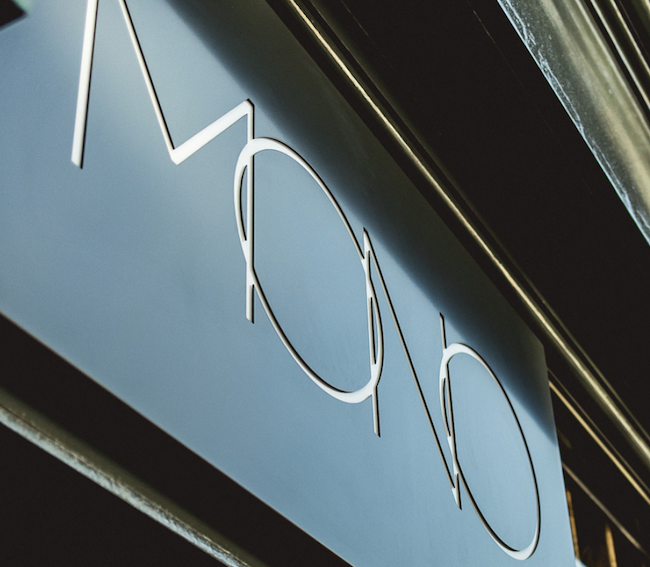
The opening in June 2018 of Mono marked a watershed in Edinburgh’s gastronomic fortunes. Whereas most fine dining restaurants are to be found in New Town and Leith, Mono’s location at 85 South Bridge, in the heart of the Old Town’s student quarter, represents a deliberate attempt to elevate the level of dining in an area replete with fast food and takeaway outlets.
Mono is also ground breaking in using progressive northern Italian cuisine to “highlight the relationship between raw nature, the ingredients used and the cultural history.” This joint vision of chef Maciek Zielinski, who has worked in one and two starred Michelin restaurants in Rome and Milan respectively, and Joseph Crolla of Crolla’s Italian Kitchen in Musselburgh, is supported by a research lab / development kitchen in which dishes are invented, tested and refined, employing both classical and contemporary techniques.
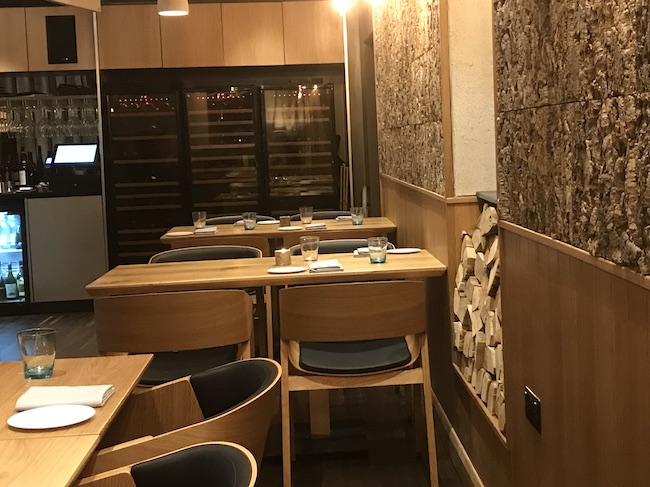
Serious investment is also seen in the restaurant design and materials used. A Nordic/ Eastern European theme where wood predominates has been chosen, although here it is brighter and lighter than other restaurants of similar design. Untreated walls, partly lined with cork, parquet flooring and comfortable upholstered smooth wooden chairs exemplify the “textural” element of the promised “multi-sensory” experience, whilst an open kitchen and beautifully presented dishes qualify for the “visual” descriptor. A wood burning stove, pendant and spotlighting together with piped music are encompassed in “sound and all kinds of stimuli” The overall effect is pleasing in its natural simplicity.
The ground floor dining room and long bar is mainly used for lunches and pre dinner drinks, whilst the heart of Mono lies downstairs, where guests can enjoy dinner with a view of the open kitchen.
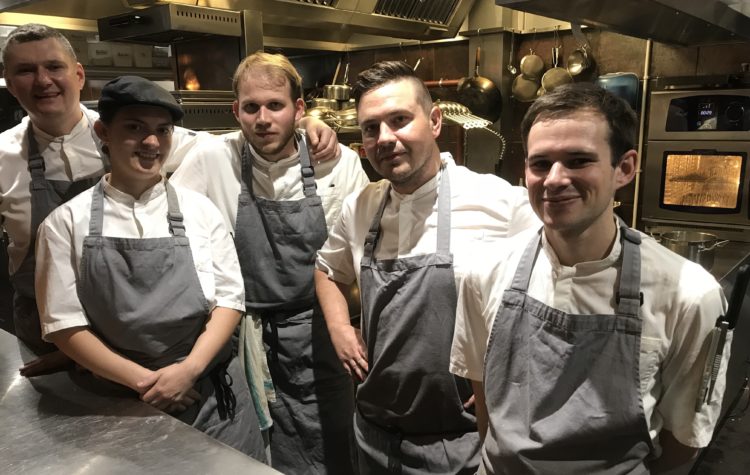
Chef Zielinski’s (far left, above) cooking is unashamedly complex and labour intensive. Modern Italian approaches fused with Scottish and Asian produce and influences reflect a degree of invention and creativity that is measured and assured: unusual combinations work, with each component harmoniously adding to the finished whole. Dishes are multi component with layers of bold flavours. A balance of tastes, textures and temperatures is evident throughout. Presentation is stylish without being over contrived. Uncompromising in their seasonality and locality, the finest Italian and Scottish ingredients are sourced, menus being changed every six to eight weeks. With a maximum of 70 covers, including the private dining room, a brigade of six in the kitchen and 4-5 front of house are kept busy.
The dinner menu has six starters from £10 to £12; six mains from £19 to £27; and six desserts all at £10. A six course tasting menu at £75, with an optional wine flight at £60, features dishes from the carte in smaller portions and is the best way to sample the range and versatility of the kitchen. Menu descriptions are terse and understated, giving an element of surprise to the diner. Prices are high but realistic given the skill in cooking and the exceptional quality of the ingredients.
Mono is open seven days a week – highly usual for restaurants of this quality – which facilitated a visit on a Monday evening to sample the tasting menu.
The assortment of breads, Focaccia with rosemary, rye, crispbread and grissini stick, were exemplary in their crusts and crumb, the focaccia being especially moist and fragrant. Dipped in the extra virgin olive oil, they were a delight.
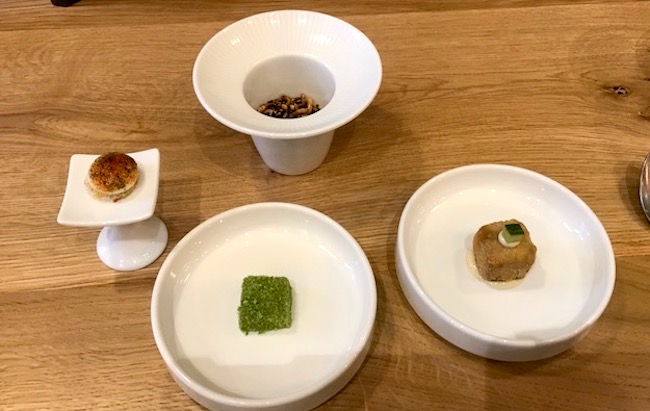
The meal began with four stuzzichini or amuse bouches: a succulent cube of crispy lamb belly dressed with a punchy bagna cauda of anchovies, garlic and olive oil; earthy, rich butternut squash puree with crispy rice; a delicate jellied rabbit consommé with parsley; and a caprese bomb of mozzarella, basil, and tomato which captured the essential flavours of Italy in one melting mouthful. These dainty morsels, inventive and with great attention to detail and bold flavours, augured well for the courses to come.
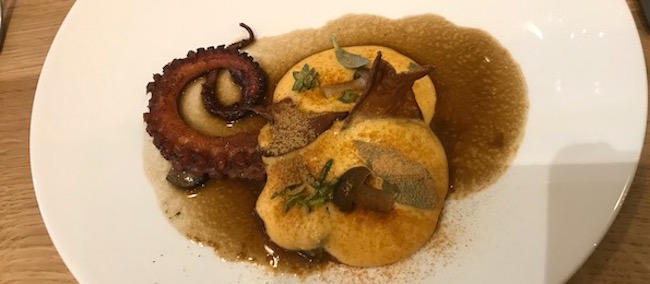
Next came a unique take on an Italian classic: octopus alla piastra. The slow cooked tentacle, tender in texture and clean in flavour, came with an ethereally light potato and paprika foam, a salad of dehydrated oyster mushrooms and a deeply flavoured dashi mushroom sauce which bought the dish together. This was a tour de force of fusion cooking, embracing Italian and Japanese elements in an umami taste sensation.
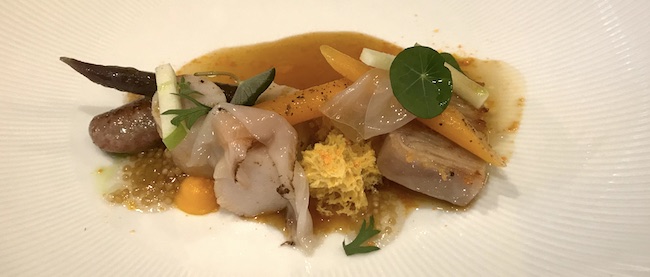
A dish of accurately timed rabbit loin came with its more flavoursome belly and kidney. Strips of lardo added richness and mustard seeds gave an aromatic touch which did not overwhelm the delicate flavour of the rabbit. The vegetable accompaniment came in a variety of forms – baby carrot, carrot sponge, carrot purée and powdered carrot – each demonstrating a different cooking technique. Nasturtium flowers added a peppery note, whilst a light jus rounded off the dish.
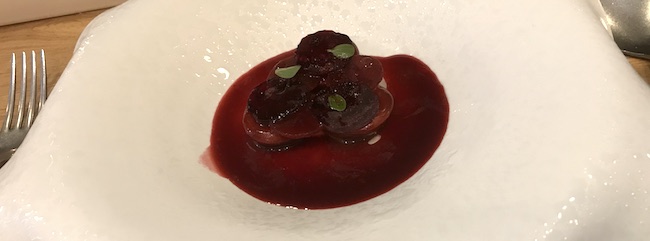
Although not as visually appealing as the other dishes – it being essentially monochrome in appearance – the next course was equally accomplished. The silky pasta of beetroot tortellini encased Katy Rodger’s rich and crumbly crowdie cheese. With discs of fermented and dehydrated beetroot, and a fermented beetroot soup, this comprised a successful marriage of flavours and textures demonstrating considerable technical skill. Here, the union of an Italian staple with Scotland’s ancient cheese was a truly inspired creation.
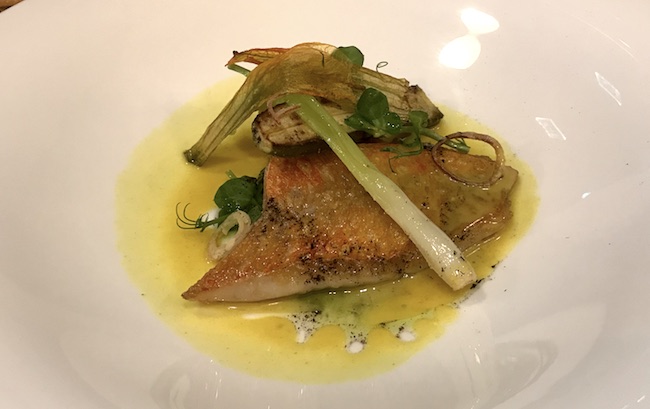
Fillets of crisp skinned, firm fleshed red mullet were accompanied by seared spring onion, crispy courgette flower and a head of zucchini encased in a cube of fried bread. The most innovative element in this Italian – Indian fusion was the mild curry butter sauce which complemented the delicate flavour of the fish.

Scottish and Italian influences were clearly evident in the meat course. A noisette of Borders lamb saddle was cooked and rested to a perfect pink, maximising its rich flavour and firm texture. Seared sweetbreads had a delicate creaminess, adding contrast and a luxurious touch. Puffy pillows of gnocchi Romana, smooth pea puree and slightly bitter chard proved suitable accompaniments, whilst powdered capers and a chilli, lamb and lovage sauce lifted the whole dish.
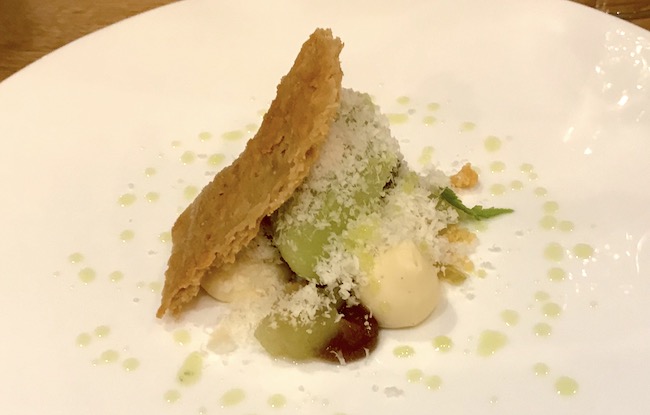
The cheese course proved a finely judged combination of Parmesan cream, tarragon sorbet, roasted apple purée, and chicory marinated in star anis, all topped with a Parmesan buckwheat shortbread. The dairy, herb and spice elements worked well together, enhancing the soft and crisp textures and salty and sweet components. This was another highly creative dish.
The following coconut and curry sorbet served its purpose in refreshing the palate for the final two courses
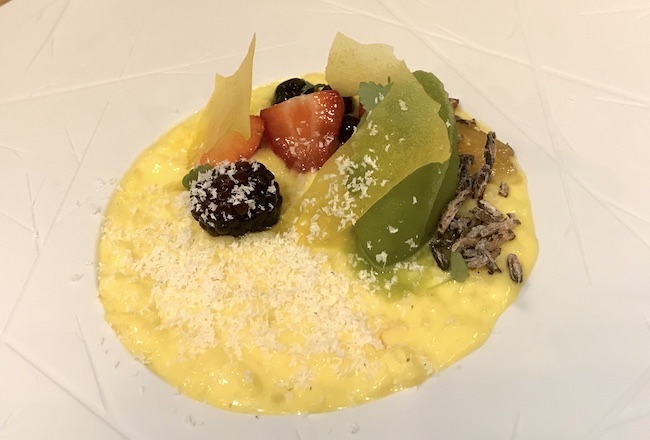
A rich and creamy saffron risotto was balanced with Scottish berries, lemon balm sorbet and meadowsweet for sweetness and herbal fragrance. Puffed rice gave contrasting texture and, as a playful flourish, a block of white chocolate and pepper, masquerading as Parmesan, was shaved for at the table.
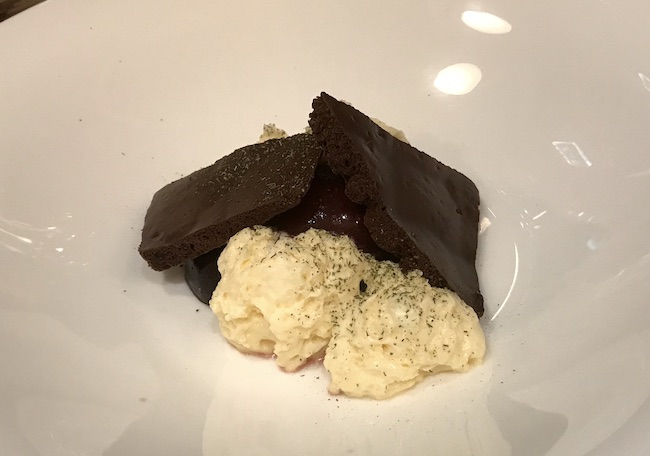
The second dessert, billed as “Cherry and chocolate” was Mono’s novel interpretation of Tiramisu. Mascarpone cream, flavoured with cherry Grand Marnier, was paired with a sorbet of tonka bean and cherry to imitate the feel of a cherry stone in the mouth. Aerated chocolate and coffee and cacao nibs crumb dressed with cherry and balsamic vinegar finished this sophisticated dessert of contrasting tastes and textures.
A cherry habits and coffee cocktail, specially invented by bartender Mattia and sommelier Roberto to accompany this dessert, proved a delicious, perfect match.
Overall, this was a most memorable meal, full of excitement and surprises, reflecting the creativity and dedication of the kitchen. The whole experience was enhanced by the welcoming relaxed formality of the seamless service, overseen by assistant manager Lukasz. At my table Roberto was able to describe each course in detail and with enthusiasm – something rare in even top flight restaurants – while Alessio served matching wines with a maturity and passion of someone truly engaged with his craft.
Although having only been open for three months, Mono is rapidly establishing its credentials as a destination restaurant. Certainly, it deserves to be successful in the highly competitive world of Edinburgh high end restaurants and there is a market for adventurous cuisine of this type. Fine Dining Guide hopes to visit again and will follow its progress with interest.



